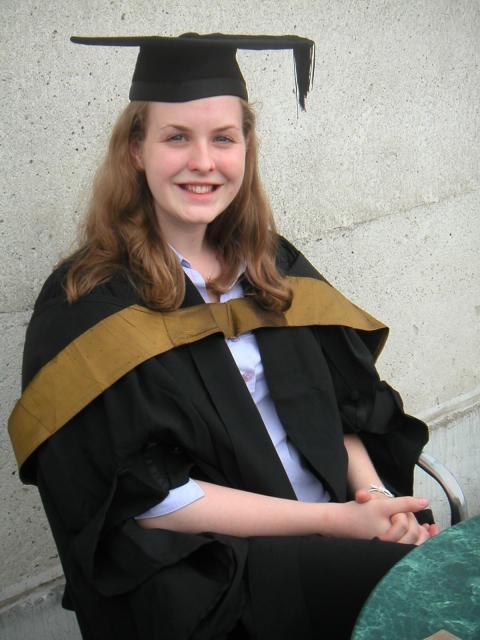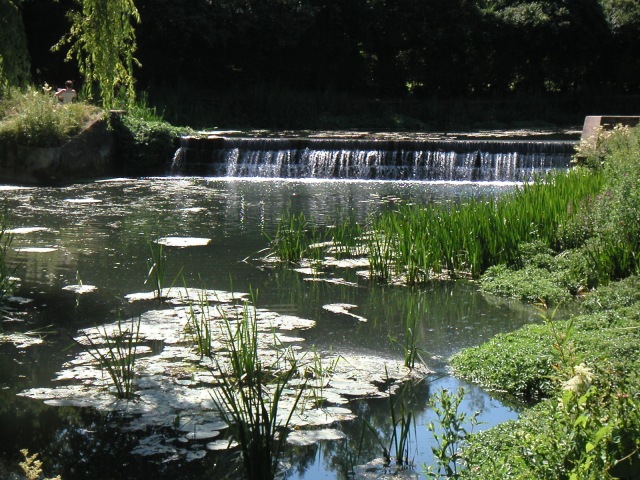July 16, 2003
Graduation Ceremony
 We are off to Cardiff to participate in the ceremony called graduation. Jena participates in that she gets doffed or docked or whatever it is they do in Cardiff. Her mother and I participate by watching and clapping more enthusiastically than we clapped the others. I wonder if Jena is doing this just to please her parents? What is graduation day all about?
We are off to Cardiff to participate in the ceremony called graduation. Jena participates in that she gets doffed or docked or whatever it is they do in Cardiff. Her mother and I participate by watching and clapping more enthusiastically than we clapped the others. I wonder if Jena is doing this just to please her parents? What is graduation day all about?
Is it a target, something to motivate the student through the years of lectures, tutorials, essays, projects and examinations? Hmm. Its winter cold and raining and dark at 8.30 in the morning and the student has a 9.00 lecture. Will anticipation of the graduation ceremony have much effect turning her out from under a warm duvet. I don't think so. The different classes of degree might be motivators, but not the ceremony.
Perhaps its long term marketing. An acceptance into the club of Cardiff graduates, that should be remembered with fondness and pride, so that when the student isolder and a little richer, she will make generous donations to her alma mater. Perhaps, but is it the ceremony one remembers? I remember my university city, Thins the bookshop, the brisk march to Kings Buildings because I enjoyed what I was doing, the friends and the long walks through Morningside in the wee sma' hours when I couldn't sleep. All I remember of graduation day is my father being displeased that I did not thank him adequately for the support he had given to help get me there. If its marketing, its not aimed at the students.
So perhaps it is a ceremony with the same cause and purpose as other ceremonies such as marriage, coronation and the state opening of parliament. Marriage and coronation seem to be about public affirmation of a new state of affairs. The marriage ceremony is about making a promise to society, and perhaps to God, that in past times was a pre-requestite for sex. Coronation is a pubic affirmation of a new state of state affairs, made to members of society and to other nations. They are also a chance to show off wealth, status and power.
The above was written before we went. Having attended the ceremony, there is another aspect to it. It is about performing a process, and doing so in public, where it can be seen to be being done properly. The relevant professor proposes that his student be accepted by the university into the community of graduates with a particular degree, and the university accept the recommendation.
Whatever the social role of ceremony, Jena graduated from Cardiff university with a first class honours degree in Psychology. Well done Jena.
July 13, 2003
Making new languages on a global scale
 Visiting Blackwell's the bookshop at the top of Park Street, I bought a print of this painting to hang on the wall of my ''cube'. I first used this image as a joke to try to liven up a rather dull talk I gave on the RDFCore working group at the W3C track of the WWW 2003 conference in Budapest. The joke did not go down well, though it seemed apt to me, as the W3C are indeed building a tower of languages and protocols designed to operate on at least a global, if not a heavenly,scale. If we are not careful, the W3C's efforts could suffer the same fate as the fabled original tower, due to the various contributors failing to speak the same language.
Visiting Blackwell's the bookshop at the top of Park Street, I bought a print of this painting to hang on the wall of my ''cube'. I first used this image as a joke to try to liven up a rather dull talk I gave on the RDFCore working group at the W3C track of the WWW 2003 conference in Budapest. The joke did not go down well, though it seemed apt to me, as the W3C are indeed building a tower of languages and protocols designed to operate on at least a global, if not a heavenly,scale. If we are not careful, the W3C's efforts could suffer the same fate as the fabled original tower, due to the various contributors failing to speak the same language.
By language here, I do not mean Greek or Hewbrew or Arabic or French, but rather that we share sufficient common understanding and a clear enough technical language tto represent that understanding to engage in useful discussion. Much energy can be wasted on misunderstandings. This has rather been a theme of my work in W3C (I have been co-chair of the RDFCore WG for the last two years).
It started when I first became interested in RDF and the semantic web. The RDF interest mailing list was reasonably active, with discussions that could, on occasion, get heated. Yet much of that heat seemed to be caused by folks with a particular conceptual model of the topic under discussion regarding as idiots all those who did not share that model. I'm sure I fell, and still fall, into that trap myself.
When we started the RDFCore WG to refine the specifications that had prompted all that discussion, I wondered how such misunderstandings could be avoided. The approach I wanted to take was to express the specifications with greater mathematical formalism. The original specifications provided some formalism, but left many questions unanswered. Pat Hayes, a well known logician from the AI community, joined the WG and brought with him the expertise to build a formal mathematical model of our specifications.
At first this worked very well. The mathematics, and it did not require anything more than elementary mathematics to understand it, (producing it is another matter), gave us a common language in which we coulld discuss issues clearly, and we made great progress. It also gave us a language that helped expose fundamental differences of view that might not have been visible without it. At least one of those issues took nearly a year to resolve.
Over the last few months, Pat Hayes with help from colleagues on the web ontology working group have been working hard to perfect this mathematical expression of the specification, and it has seemed to me, that getting this right to the satisfaction of the mathematicians has been taking a while.
More, as co-chair of the WG, I feel pretty vulnerable, in that very few people can do the work that Pat is doing. It is difficult for the WG to review this work thoroughly, far less take it over should Pat, for any reason, be unable to continue working on it.
Also, I worry that we are over specifying; that things which perhaps should be left ambiguous, perhaps because we don't have the practical experience to make the right chocies now, or perhaps because there is no need to so restrict all implementations, are being unnecessarily or unwisely restricted.
And then I remember what is happening on the TAG and with the updating of RFC 2396, the URI specification. There, the same sort of misunderstandings that I saw on the RDF interest list, seem to happening again, but now in the context of the very heart of the architecture of the web.
So, as I urged during my talk at the W3C tech plenary this year, I would still like to see more precision and greater formalism brought to bear in these architectural discussions, not just becaue that enables more precise specification, but more importantly, it gives a common langauge for us all to discuss the real issues. We just have to remember, that whilst these tools give us the power to express things with great accuracy, just as we learned not to overspecify the accuraccy of our numbers, 1.0 being a very different thing from 1.00000, we must remember that the formal model is a tool, not an end in itself.
The print of Breugel's painting hangs on my cube wall, to remind me that it is the language of mathematics that enables architects and engineers to build, or to know not to bother trying to build, bridges, tunnels and of course, towers.
July 12, 2003
Cycling day
 Saturday was a cycling day, from home to Wotton-under-Edge, up the escarpment to the plain behind, on to the small town of Tetbury, which specializes in antique shops, on to the old market town of Malmesbury with its ancient hilltop abbey and new hi-tech industry, then back through the modern dormitory town of Yate to home. In all fifty miles according to the meter on my bike, which is further than I intended to go and left me quite tired as I cooked Saturday nights dinner of beef bourguignon.
Saturday was a cycling day, from home to Wotton-under-Edge, up the escarpment to the plain behind, on to the small town of Tetbury, which specializes in antique shops, on to the old market town of Malmesbury with its ancient hilltop abbey and new hi-tech industry, then back through the modern dormitory town of Yate to home. In all fifty miles according to the meter on my bike, which is further than I intended to go and left me quite tired as I cooked Saturday nights dinner of beef bourguignon.
The picture is of weir, down the steps below the abbey. I took a wrong turning and was cycling through a dry, arid (it was a hot day) industrial estate, when I reached this oasis of cool green.
Going up the steep hill behind Wotton, I was met with about twenty or so cyclists, spread out, going the other way. I suspected that this was the annual Alveston Audax ride, a day long 100km ride through the Cotswalds. Checking the Audax UK calendar, the ride was yesterday. Its a shame I didn't know it was on as I'd have joined it. As it was, they were gliding down that hill near the end of their journey as I struggled up near the beginning of mine.
But then I saw a hawk, a Sparrow Hawk at a guess, brown, about the size of seagull. I surprised it, and it me, as I rode along. After startling into the air, it flew along a parallel track, about 6 metres off the ground for a while. I couldn't watch it properly as I had to keep looking where I was going. One day, about nine months ago, I didn't look where I was going and spent a day in casualty and another buying a new bike as a result. I try not to do that any more.